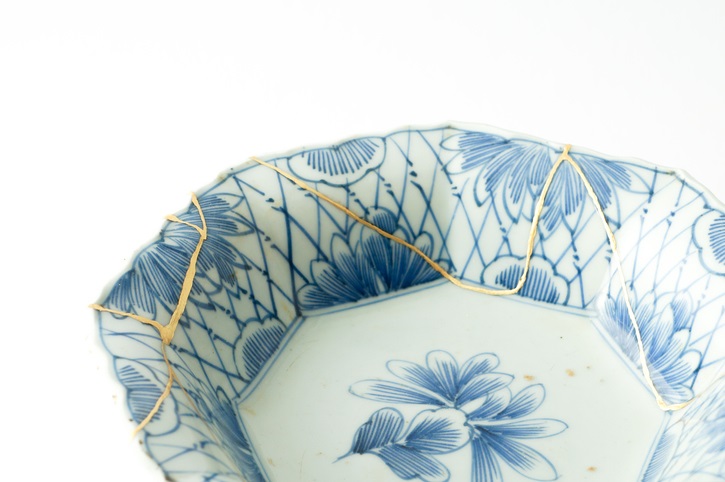How Kintsugi Can Teach Us About Resilience

If you’ve ever seen a piece of pottery with golden cracks throughout it, you were likely looking at something in the style of kintsugi. A Japanese art form dating from the 15th century, kintsugi (generally translated as “to join with gold”) is a distinctive pottery repair method. Kintsugi artists mend the broken pieces with lacquer, and then trace the cracks with powdered gold, silver, or platinum.
But kintsugi is much more than creating beautiful objects—it’s rooted in Japanese philosophies and world views. It embodies mottainai, the regret over waste, and wabi-sabi, the celebrating of and finding beauty in imperfections. With pottery breaks highlighted instead of hidden, the fracture is now a beautiful part of the piece’s history and makes it unique, and the original piece is reborn for future use. In this way, the art of kintsugi serves as a powerful metaphor for life.
In just one piece of pottery, kintsugi teaches us about accepting fragility, building strength and resilience, and taking pride in the imperfect. Things can and do fall apart. Of course, we know that uninvited challenges and mistakes are how we grow, learn, and change, but that truth still doesn’t make them any easier.
While we tend to see others’ struggles and vulnerability with compassion, grace, and even admiration, we have a much harder time allowing and accepting our own in the same way. And when our lives are turned upside-down by difficult changes, turmoil, loss, and challenges, it’s often not easy to adjust and accept them.
Life events like the passing of a loved one, a serious health diagnosis, or moving from a family home that no longer fits health needs can all bring up feelings of loss, grief, and fear. But we actually have things that serve as our “lacquer” to hold us together. Our sense of purpose, social connections, support networks, and healthy stress management can all help us build resilience, that ability to adapt to and recover from adversity. And as it turns out, seniors in particular are thought to have higher levels of resilience—in part because of their capacity to recover from crisis and stress.
When moving to a senior living community is not part of the original life plan, the choice to do so can be emotionally challenging. Mallory Mixdorf, Director of Resident and Family Supportive Programs at Era Living, has seen many seniors in these situations adapt and flex to their new normal. “We have found that many [of our] residents often ‘rise from the ashes’ and, once they settle into their new home, truly thrive mentally, physically, emotionally and spiritually at our communities,” she says.
Mallory also pointed out that social and support networks, which help to build resilience, can often be found in senior living. “The communities within Era Living have been able to foster a deep bond between residents, and this is certainly a massive tool for our residents: the tight network of colleagues, friends, and staff,” she adds.
“Seniors are probably the most resilient age group,” says Mallory. “We are continually impressed and humbled by the way our residents are able to manage stressors, major life events, and loss of loved ones—and continue to see the positive side of life.”
In an interview with the BBC, kintsugi restorer Hiroki Kiyokawa talks about his belief that all things are created and destined to be broken. “I think being broken or damaged is never a bad thing,” he says. “Our imperfections can be the birth of something new.”
In a society that prizes youth and flawlessness and discards broken objects, we’re sent messages that resist this idea. But by finding beauty and potential in the broken pieces, kintsugi teaches us to accept and celebrate how we’ve come back from struggle. We can think of any hard experiences as the breaks needed to develop our own golden repairs.
Kiyokawa describes any fractured part where he applies kintsugi as becoming “a new landscape in itself.” When we’re in the darkest of hard times, it can be difficult to maintain that optimistic perspective. So it may help to keep a piece of kintsugi art where you can see it every day. It’s a visual reminder that we can use our resources, build resilience, and hope in possibilities—and create that new landscape.
Here at Era Living, we’re always thinking of resources and topics of interest for our residents and all seniors. To get ideas and tips on topics like healthy living, caregiving, and moving, subscribe to our monthly newsletter.
Related Posts

Podcast: A Day in the Life at Era Living – Resident Diane Miller

Podcast: Advocating for Retirees in Senior Living

